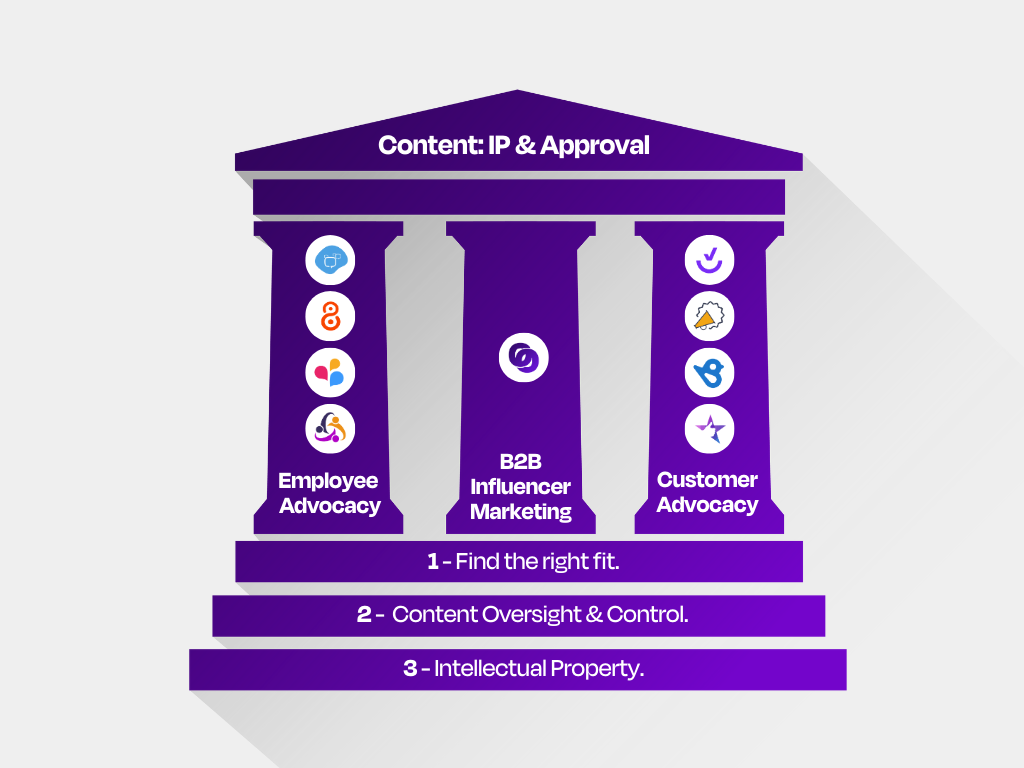Content : IP & Approval in B2B Influencer Marketing
Hector Forward • 2024-05-04
In our last blog post we went a little deeper into Disclosure & Transparency within influencer marketing. i.e External guidelines you need to be aware of and follow. This is a deeper dive into the second important control element of your advocacy program. Your own guidelines for employees and/or customers and/or external subject matter experts.
Your own guidelines for employees, customers & external subject matter experts
Find the right fit, first.
Choosing the right influencer is crucial. Partnering with someone whose values don't align with your brand, or who has a history of controversy, can backfire. Influencers are human, and they can make mistakes or get caught up in controversies. If something negative happens with an influencer you've partnered with, it can reflect poorly on your brand. Do your research before partnering with someone.
Lack of Alignment: This is a risk in both influencer marketing and customer advocacy. If the influencer's area of expertise or the customer advocate's experience doesn't align well with your brand message, it can lead to confusion or a disconnect with your target audience.
Content Oversight & Level of Control.
You have a right to ensure brand messaging aligns with your values.
The aim is not to stifle creativity. The goal is to strike a balance between allowing for authentic expression and upholding brand integrity.
Unrealistic Expectations:
Overly enthusiastic employee advocacy can set unrealistic expectations for customers. Customers might be disappointed if their experience doesn't live up to the hype created by employee promotion.
Wasted Resources:
A poorly planned employee advocacy program can be a drain on resources. Investing in training, clear guidelines, and proper tools is essential to make it successful.
Policies:
Develop clear program policies that outline expectations for customer advocates, including disclosure requirements, data privacy practices, and acceptable content guidelines.
Training and Education:
Provide training to employees on the legalities and best practices of employee advocacy. This can help them understand their role and responsibilities within the program.
For influencers, this might involve reviewing content before publishing. While you can provide guidelines, influencers have more creative freedom in their content. The level of review will depend on the influencer and the campaign, but aim for a balance between control and creative freedom.
Employees might misinterpret brand guidelines and customer advocates might share negative experiences. This can make it challenging to maintain a consistent brand narrative.
With employees, it could involve providing social media guidelines or training on brand communication. You generally have more control over content created by employees compared to influencers. While some level of control is helpful, employee advocacy thrives on authenticity. Giving employees too much script can make their messages sound robotic, while too little control can lead to inconsistent brand messaging or even the spread of misinformation. A poorly designed employee advocacy program can backfire and hurt morale.
Employees should be encouraged to promote the company and its products or services in a truthful and accurate way. Provide clear guidelines to ensure their advocacy aligns with your brand messaging and avoids misleading claims. This also helps to avoid running afoul of advertising regulations like those set by the FTC.
Employees pressured to participate inauthentically or feeling unsupported in their advocacy efforts can become disengaged.
In some cases, employee advocacy, particularly in the financial sector, could be subject to securities laws. For example, employees must be careful not to make any unauthorized disclosures about material financial information that could impact the stock market.
Monitoring and Review: Monitor employee advocacy activity to ensure compliance with program guidelines and address any potential issues promptly.
Equal Opportunity: Employee advocacy programs should be open to all employees on an equal basis, avoiding any discrimination based on factors like race, gender, or religion.
Respectful Communication: Encourage employees to maintain a professional and respectful tone in their advocacy efforts. This helps to avoid any potential for harassment or discrimination towards colleagues or competitors.
Content created by employees while on company time or using company resources might be considered the intellectual property of the company.
💫 What is 100% required
- No conflict of interests (posting things that go against company messaging or competitors etc.)
- Use opportunities to promote the company you work for when / where possible
🚩 What is crossing the line
- Preventing posting to things that are relevant to your audience but may not be fully aligned with the company (aka this case here).
- Forcing/controlling the narrative of your teams social media
Companies have more control over external influencer & employee advocacy compared to customer advocacy.
With customer advocates, it could involve monitoring social media for brand mentions and addressing any concerns. Customer advocacy relies on organic expression, making control more challenging. Customer reviews are generally unfiltered opinions, whereas influencer content can be reviewed or vetoed beforehand. Provide clear guidelines to your customer advocates about the types of claims they can make about your product or service. This helps to avoid any misleading or unsubstantiated claims that could lead to legal trouble. The most valuable customer advocacy is authentic. Encourage advocates to share their genuine experiences, both positive and negative, to foster trust and credibility.
Intellectual Property:
- If customer advocates create content for your program, ensure you have the necessary rights to use it. This might involve obtaining a copyright transfer or license agreement if they create original content like videos or blog posts. Be mindful of any trademarks they might use in their content as well.
- Content created by employees while on company time or using company resources might be considered the intellectual property of the company. Be clear in your employee advocacy guidelines about ownership rights for any content created as part of the program.
- Be clear about ownership of any content created by the influencer for your campaign. Contracts should specify who owns the rights to photos, videos, or written content produced. This avoids any confusion or disputes down the line.
See More Posts
Cardy
Copyright © 2021 Govest, Inc. All rights reserved.

